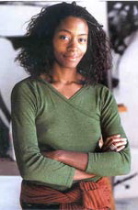
The biggest surprise Friday night at Kara Walker’s “entertainment” at the FWM was seeing Walker, dressed like a barefoot, pipe-smoking, 3-D approximation of one of her cut-paper silhouettes. When Libby, our friend Bay and I got entry to Walker’s installation (people were allowed in ten at a time and asked not to linger too long), she was sitting on the floor like an element in the piece, just another prop. She was not the first thing we noticed. (see Libby’s post for more.)
The room was dark and the lighting came from several small video projections and from the many small and one large cyclorama that cast flickering light and color onto walls, ceiling, floor and the props. A little pup tent reminded me of childhood and acting out plays in the backyard. In fact, the whole thing kind of reminded me of a stage set for children to act out stories. (Top image is Walker and below is one of Walker’s large non-linear narrative works, “Gone: a history of romance of a Civil War as it occurred between the dusky thighs of one young Negress and her heart.”)
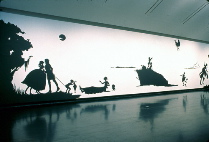
The moving lights gave it all a summery, firefly-lit affect.
The star in the dark space, the Venus in cosmos Fibbergibbet, was the video projection on the screen of a woman dancing the Charleston. It was among the smallest elements but it was the most compelling.
As with most everything else in Walker’s world, the dancer was back-lit and her body became a flat silhouette. She danced the jerky steps, her legs and arms a constant flow of up-down, spin around motion. Because the video had been speeded up, the jerky motion was accentuated and the dancer seemed a marionette doing a kind of St. Vitus’ dance. At the end, she’s so tired she has to pick up each leg to move it, but she keeps on moving.
It was mesmerizing. It was almost all I wanted to look at.
(next four images: Kara Walker In collaboration with The Fabric Workshop and Museum, Phila, “Fibbergibbet and Mumbo Jumbo: Kara E. Walker in Two Acts” (details), 2004, Image courtesy of the artist and the FWM. Photo: Aaron Igler)
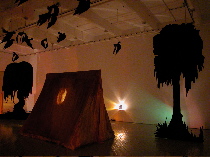
Bay whispered to me “There’s somebody in the tent.” Indeed there was. Bay thought it was a man but he was dressed as a woman.
Just then, Walker stands up and begins reading from a sheet of paper. In the tent, banging and clanging of pots ensues. Walker reacts and continues reading in a flat voice, uninflected with any kind of emotion. At some point a large man, dressed in a bonnet and burlap sack with the letters “K.W.” stitched on it emerges from the tent. The two have a stare-down.
The spoken words are garbled and I catch a few. “Sure is dark in here….stop laughing and reload…you going to the barbecue? they are roasting the bones of our ancestors…it’s a live feed … there isn’t much to be seen of a negress in the dark…you haven’t seen her have you…what’s orange and black and beautiful to behold? a nigger on fire….overhead the crow flies..war is near its end..they spoke with soft, sweet…allow me to step outside a conversation I have so carefully allowed to elaborate.”
With those last words — pretty much mumbo jumbo if you ask me — Walker steps outside the room, the man gets back in the tent and not knowing whether it’s over or not, we stand around for a minute or two before leaving.
Bottom line, the live action was as circular as what was on the cycloramas.
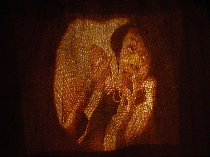
Walker is not a linear storyteller.
The live action felt like childs’ play enacted by a child for a parent. It also felt like a kind of experiment of the artist in her space attempting to relate to it in a new way.
If there’s genius in the piece it’s in the two small video works — the Charleston dancer and the piece projected on the tent which shows Walker dressed in bonnet playing out the “Negro aphorisms” that were projected on a small arrow pointing at the tent. Both seem to carry on Walker’s obsession with the role of African American women in the south and elsewhere. Both video components, I think, could stand alone and yet they worked well as elements in the theatrical set-piece.
I revisited the work yesterday and was alone with the installation long enough to write down many and some of the aphorisms which began “Many black women”… or “Some black women”…
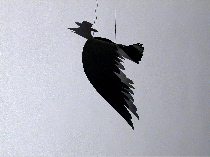
The aphorisms covered every stereotype and cliche, from good girl to bad. And I’m thinking the Charleston dancer and the girl in the bonnet projected on the tent are both “some” and “many” black women, as is Walker herself.
While I think the live action didn’t do much for the piece, I did find it most compelling to see the artist — dressed as one of her stock characters — in her work. It made it all the more clear her identification with her material.
It’s great the Fabric Workshop provides a space and support for artists to experiment and take risks. You can scratch your head at the results, as we’re all doing here, but in the end, I’d rather have a new Kara Walker piece to mull over than a lot of other things.
Finally, because we all love this kind of detail, here are some behind-the-scenes tidbits from Blake Bradford and other staff at the FWM.
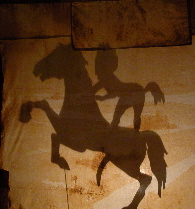
The man in the tent? Walker’s cousin, James Hannahan, a writer studying for an MFA in writing at the University of Texas, Austin.
The four-piece band at the opening? “The Ebony Hillbillies,” out of New York, a Black string band playing traditional music. Walker picked the band to play at the opening. (You can hear the band live at the Grand Central Shuttle Terminal on April 28 as part of the Music in the Subway celebration.)
References in the piece come from Harriet Beecher Stowe’s second book “Dred, A tale of a Great, Dismal swamp” (1856). Read a conversation with Walker and MOMA curators from 1999.









